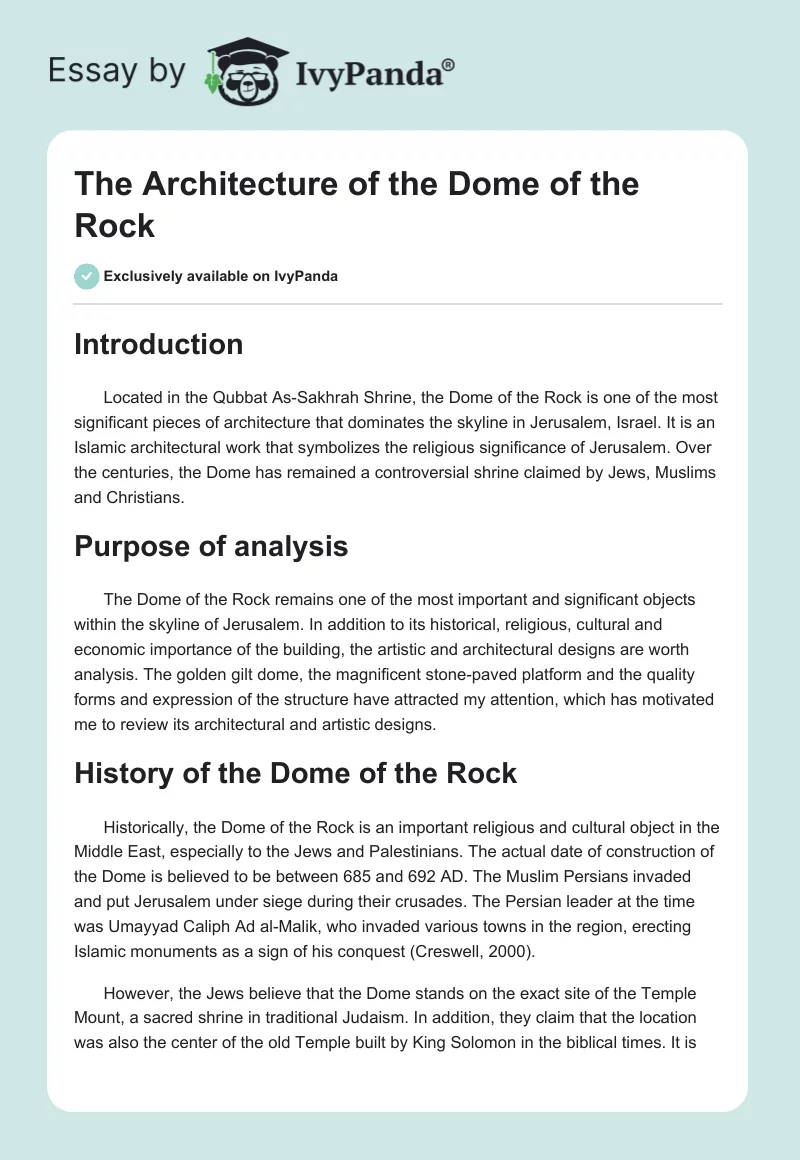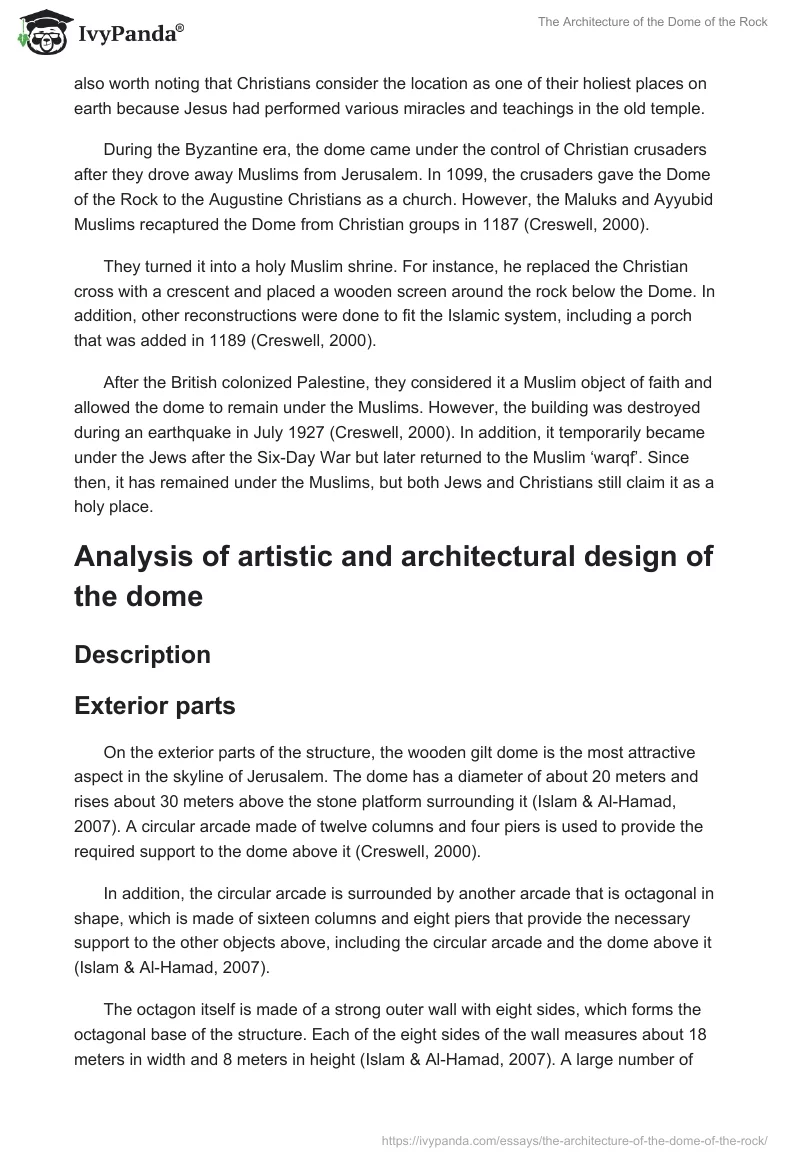Introduction
Located in the Qubbat As-Sakhrah Shrine, the Dome of the Rock is one of the most significant pieces of architecture that dominates the skyline in Jerusalem, Israel. It is an Islamic architectural work that symbolizes the religious significance of Jerusalem. Over the centuries, the Dome has remained a controversial shrine claimed by Jews, Muslims and Christians.
Purpose of analysis
The Dome of the Rock remains one of the most important and significant objects within the skyline of Jerusalem. In addition to its historical, religious, cultural and economic importance of the building, the artistic and architectural designs are worth analysis. The golden gilt dome, the magnificent stone-paved platform and the quality forms and expression of the structure have attracted my attention, which has motivated me to review its architectural and artistic designs.
History of the Dome of the Rock
Historically, the Dome of the Rock is an important religious and cultural object in the Middle East, especially to the Jews and Palestinians. The actual date of construction of the Dome is believed to be between 685 and 692 AD. The Muslim Persians invaded and put Jerusalem under siege during their crusades. The Persian leader at the time was Umayyad Caliph Ad al-Malik, who invaded various towns in the region, erecting Islamic monuments as a sign of his conquest (Creswell, 2000).
However, the Jews believe that the Dome stands on the exact site of the Temple Mount, a sacred shrine in traditional Judaism. In addition, they claim that the location was also the center of the old Temple built by King Solomon in the biblical times. It is also worth noting that Christians consider the location as one of their holiest places on earth because Jesus had performed various miracles and teachings in the old temple.
During the Byzantine era, the dome came under the control of Christian crusaders after they drove away Muslims from Jerusalem. In 1099, the crusaders gave the Dome of the Rock to the Augustine Christians as a church. However, the Maluks and Ayyubid Muslims recaptured the Dome from Christian groups in 1187 (Creswell, 2000).
They turned it into a holy Muslim shrine. For instance, he replaced the Christian cross with a crescent and placed a wooden screen around the rock below the Dome. In addition, other reconstructions were done to fit the Islamic system, including a porch that was added in 1189 (Creswell, 2000).
After the British colonized Palestine, they considered it a Muslim object of faith and allowed the dome to remain under the Muslims. However, the building was destroyed during an earthquake in July 1927 (Creswell, 2000). In addition, it temporarily became under the Jews after the Six-Day War but later returned to the Muslim ‘warqf’. Since then, it has remained under the Muslims, but both Jews and Christians still claim it as a holy place.
Analysis of Artistic and Architectural Design
Exterior parts
On the exterior parts of the structure, the wooden gilt dome is the most attractive aspect in the skyline of Jerusalem. The dome has a diameter of about 20 meters and rises about 30 meters above the stone platform surrounding it (Islam & Al-Hamad, 2007). A circular arcade made of twelve columns and four piers is used to provide the required support to the dome above it (Creswell, 2000).
In addition, the circular arcade is surrounded by another arcade that is octagonal in shape, which is made of sixteen columns and eight piers that provide the necessary support to the other objects above, including the circular arcade and the dome above it (Islam & Al-Hamad, 2007).
The octagon itself is made of a strong outer wall with eight sides, which forms the octagonal base of the structure. Each of the eight sides of the wall measures about 18 meters in width and 8 meters in height (Islam & Al-Hamad, 2007). A large number of windows occupy the largest section of the dome and the outer walls. This feature is important in increasing the aesthetic value of the structure (Islam & Al-Hamad, 2007).
The artistic nature of the outer walls is another important feature that attracts the eye of the viewer. The walls contain an extensive decorative feature developed by various forms of artwork, including painted wood, carved stones, durable carpets, marbles and tiles of different colors and mosaic patterns that present different colors and textures (Islam & Al-Hamad, 2007).
History indicates that most of these decorations were made several years after the establishment of the original structure. For example, more than 40,000 blue and yellow tiles were placed on the inside and outside parts of the walls in 1500s under the leadership of Suleiman the Magnificent (Peterson, 2004).
Interior parts
The interior parts of the structure bear the greatest artistic work of decoration. In fact, elaborate mosaics covering the entire walls occupy an area of about 1,200 square meters. These aspects were developed with an aim of decoration as well as enshrining the Rock below the magnificent Dome.
The mosaics display extensive application of geometry because much of the intricate patterns show a variety of geometrical shapes rather than figurative design. According to Islamic beliefs, it is impossible to represent the will of God in a figurative form (Ettinghausen & Grabar, 2010).
Conclusion
The artistic nature of the Dome makes the structure magnificent and attractive to the viewer’s eye. In fact, these aspects attract the attention of the viewers more than the historical aspects of the Dome. Despite the long history of the building, the artistic and architectural designs remain attractive to the viewers, which show evidence of the original features placed under the Islamic conquest.
References
Creswell, K. (2000). The Origin of the Plan of the Dome of the Rock. Jerusalem: British School of Archaeology.
Ettinghausen, R., & Grabar, O. (2010). The Art and Architecture of Islam 650-1250. New Haven, CT: Yale University Press.
Islam, M. A., & Al-Hamad, Z. (2007). The Dome of the Rock: Origin of its Octagonal Plan. Palestine Exploration Quarterly, 139(2), 109–28.
Peterson, A. (2004). Dictionary of Islamic Architecture. London, UK: Routledge.


